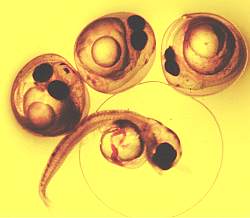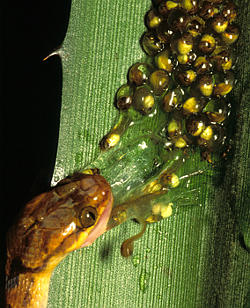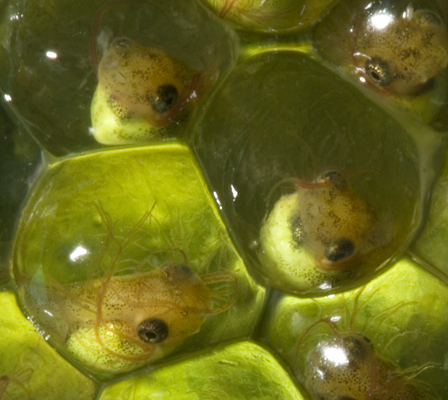SICB Annual Meeting 2011
January 3-7, 2011
Salt Lake City, UT
Symposium: Environmentally-Cued Hatching Across Taxa: Embryos Choose A Birthday
Environmentally cued hatching is widespread, diverse, and certainly more common than currently appreciated. The symposium focuses on hatching as an ecologically critical, developmentally constrained, plastic life history switch point. It examines embryos as organisms subject to natural selection, capable of receiving environmental cues, and often able to respond to those cues with adaptive modulation of their own hatching timing. It will build a unified conceptual framework for broadly integrative and comparative work on hatching plasticity and embryo responses to their environment, reveal commonalities and differences across taxa, environmental factors, and mechanisms of plasticity, and identify important areas for future research.

Hatching Grunions (Photo by Rachel Darken)
TThere has been no previous attempt to compare hatching plasticity across widely divergent taxa or contexts. The symposium will foster an integrative and comparative approach by bringing together people who study adaptive hatching timing in a diverse range of organisms that use different kinds of environmental information in different ecological and functional contexts. The organismal diversity discussed in the symposium will include parasitic flatworms, free-living annelids, molluscs, crustaceans, fishes, amphibians, reptiles, and birds with environmentally cued hatching.
Similarly, no previous attempt has been made to integrate and compare research on hatching plasticity across responses to different environmental factors. The symposium will address responses to a variety of physical conditions, biotic risks, and resources. Symposium speakers will address two types of mechanisms underlying environmentally cued hatching plasticity: the developmental and physiological mechanisms that allow embryos to hatch or remain in the egg over a broad range of ages or developmental stages, and the pathway connecting environmental conditions with the hatching process to determine individual hatching timing. Speakers will address the selective forces and developmental constraints shaping hatching timing and hatching plasticity, the ecological importance of environmentally cued hatching, and the relative roles of embryos and parents in hatching timing.
Environmentally cued hatching plasticity is of fundamental importance for understanding early life history, reproductive ecology, and embryos as environmentally responsive organisms. Research in hatching plasticity integrates many different areas of biology including ecology, evolution, and life history theory, developmental biology and physiology, and animal behavior.
Sponsors
This symposium is sponsored by the following divisions: DAB, DCPB, DDCB, DEDB, & DIZ

Tree frog embryos hatching prematurely to evade an egg-eating snake (Photo by Karen Warkentin)
Organizers
- Karen Warkentin is an Associate Professor at Boston University and a Research Fellow with the Smithsonian Tropical Research Institute in Panama.
- Karen Martin is Frank R. Seaver Professor of Biology at Pepperdine University in California and a Research Associate in Marine Biology at Scripps Institution of Oceanography.
- Richard Strathmann is Professor Emeritus at University of Washington and former Associate Director of Friday Harbor Laboratories.
Outline of Program
S8.1 Thursday, Jan. 6, 08:00 WARKENTIN, K.M.:
Introduction to the Symposium – Eggs as organisms: environmentally cued hatching and adaptive embryo responses to risk and opportunity
S8.2 Thursday, Jan. 6, 08:30 MARTIN, Karen L*; BAILEY, Karen J; MORAVEK, Cassadie L; CARLSON, Kjirsten A:
Taking the plunge: How do California grunion embryos respond so quickly to sudden changes in the environment? Physiology of the response to hatching triggers for a teleost fish
S8.3 Thursday, Jan. 6, 09:00 ISHIMATSU, Atsushi*; GRAHAM, Jeffrey B:
Roles of oxygen and tidal cycle for embryonic incubation and hatching
S8.4 Thursday, Jan. 6, 09:30 DOODY, J. Sean:
Evidence for Environmentally-cued Hatching in Reptiles
S8.5 Thursday, Jan. 6, 10:30 WARKENTIN, K.M.:
Hatching plasticity in amphibians: evolution, trade-offs, cues and mechanisms
S8.6 Thursday, Jan. 6, 11:00 CHRISTY, J.S.:
Timing of hatching in Brachyuran crabs: patterns and control
S8.7 Thursday, Jan. 6, 11:30 REED, W.L.*; CLARK, M.E.:
Beyond maternal effects on avian development: embryonic responses to the environment.ail
S8.8 Thursday, Jan. 6, 13:00 MINER, BG*; DONOVAN, DA; MORGAN, C:
Predator and conspecific induced hatching in a marine snail
S8.9 Thursday, Jan. 6, 13:30 OYARZUN, F. X.*; STRATHMANN, R. R.:
Plasticity in Stage at Hatching that Controls Pelagic Duration and Dispersal in Marine Invertebrate Larvae
S8.10 Thursday, Jan. 6, 14:00 WHITTINGTON, I.D.*; KEARN, G.C.:
Hatching strategies in parasitic monogeneans (platyhelminths) that facilitate host infection
S8.11 Thursday, Jan. 6, 14:30 Strathmann, R. R.:
Roundtable Discussion

Closeup of hatching-competent tree frog embryos (Photo by Karen Warkentin)

